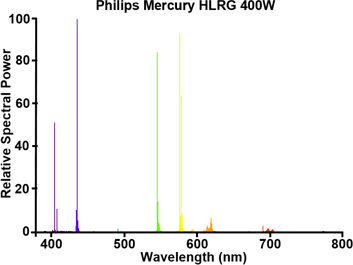
|
Philips Horticultural Mercury HLRG 400W |

A major drawback of mercury lamps and luminaires at the time was their non-homogeneous light distribution when mounted at the short distances required to attain high enough levels of photosynthetically active radiation. Plants directly under the lamps received more light than others, leading to variations in growth rates and a need for frequent movement of plants. This was solved by employing an ellipsoidal reflector with deeply-mounted arc tube, which radiates more light at wider angles than directly under the lamp. It employs a half-aluminised large bulb of a 700W mercury lamp, and the glass is internally acid-etched to achieve a broader beam with high uniformity. The reflector portion of the bulb is coated with standard yttrium vanadate phosphor, although earlier versions employed the Philips magnesium arsenate phosphor.
This lamp was produced only for a few years - by 1978 it had been replaced by an improved version having a clear front and diffuse titanium dioxide reflector, which yielded a higher light output. It was produced until the mid 1990s when the superior spectrum of special high pressure sodium lamps had taken over the horticultural lighting market.




| Manufacturer: | NV Philips Gloeilampenfabrieken | Model G/93/2 |
| Lamp Power: | 400 Watts | |
| Lamp Current: | 3.2 Amps | |
| Lamp Voltage: | 145 Volts | |
| Cap Type: | E40s/45 | Ni plated brass + vitrite |
| Bulb Type: | ED-140 | ED-44 in eighths/inch |
| Bulb Finish: | Aluminised + Phosphor | Etched Borosilicate |
| Electrodes: | Backwound tungsten | BCY emitter |
| Arc Length: | 72 mm | 2.83 inches |
| Atmosphere: | Inner: Hg | Ar (4.65 atm) | Outer: Carbon dioxide |
| Luminous Flux: | 14,000 lm | @ 100 hrs |
| Luminous Efficacy: | 35.0 lm/W | @ 100 hrs |
| Colour Temperature & CRI: | CCT:4500K | CRI: Ra17 |
| Chromaticity Co-ordinates: | CCx: 0.365 | CCy: 0.390 |
| Lifetime: | 12,000h | 88% survival, 82% flux |
| Warm-up & Re-strike Time: | 4 minutes | 15 minutes |
| Burning Position: | Universal | Vertical cap up |
| Overall Length: | 329 mm | 13 inches |
| Light Centre Length: | N/A | N/A |
| Factory: | Emmasingel, Eindhoven | The Netherlands |
| Date of Manufacture: | 1975 December | Date Code: 5M |
| Original Value: | Unknown | |
